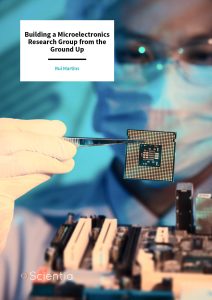Professor Rui Martins | Building a Microelectronics Research Group from the Ground Up
Microelectronics are the minuscule components that power our modern world, from your smartphone to the systems that keep jet airliners in the sky. These essential components, such as transistors, resistors, capacitors, and inductors are the building blocks of microchips – the tiny computing units that process vast quantities of binary information. However, the world around us isn’t binary. Engineers must develop ways to translate between the analogue world that we inhabit and the binary world of chips. Over the last 30 years, Professor Rui Martins of the University of Macau has built a world-renowned research lab – the State Key Laboratory of Analog and Mixed-Signal VLSI – focused on further bridging the gap between analogue and digital.
A Small World
Microelectronics are the tiny chittering components that fill your laptop, phone and washing machine, and keep planes in the air. This field has grown exponentially over the last 50 years, but the components that are developed have been getting exponentially smaller. The first computers were gargantuan, but researchers and engineers have shrunk each component by orders of magnitude, allowing circuits to become increasingly dense.
In 1965, Gordon Moore, an engineer and founding CEO of Intel, suggested that the density of transistors in circuits doubles every 18 to 24 months. Transistors are ubiquitous in modern technology, and are mostly used to store and process binary information – they can be either ‘on’ or ‘off’, represented by a 1 or 0. Moore’s Law, as it came to be known, has held true for over half a century, leading to a world where your pocket-sized smartphone has orders of magnitude more computing power than the room-sized supercomputers of the 1960s.
However, Moore’s Law isn’t like the laws of gravity or thermodynamics, but it instead describes the self-fulfilling prophecy that research will find ever more ingenious ways to achieve more with less.

‘Macao Chip by Macao People’ – First State Scientific and Technological Progress Award for Macao
Research at SKL-AMSV
Based at the University of Macau, the State Key Laboratory of Analog and Mixed-Signal VLSI (SKL-AMSV) focuses on the boundary between microscopic binary processers, and the analogue data that fills the macroscopic world we’re familiar with.
Researchers at SKL-AMSV developed novel Analog-to-Digital prototypes for the incoming 5G and Internet of Things (IOT) rollout, achieving better energy efficiency than most competitors. As the microelectronics components of Analog-to-Digital converters become smaller, the efficiency of such devices becomes more important, as the density of circuitry leads to heat that must be quickly dissipated to avoid overheating.
An Evolving University
The story of SKL-AMSV is a great case study into how to build a world-renowned research laboratory from scratch, with limited funding and resources. Through a decade of transformation, re-aligned priorities, and the careful recruitment of teaching and research specialists, the laboratory has grown dramatically.
Macao, a Special Administrative Region of China, has a unique history as an erstwhile Portuguese territory that was transferred to China in 1999. Since then, it has operated under the one country, two systems principle, reflecting the region’s unique development.
Established a decade before Macao’s transition from Portugal to China, the University of Macau initially focused on undergraduate teaching and employment-oriented courses, with limited original research or opportunities for postgraduate engineering projects. Fewer students were enrolling in science and engineering subjects each year, and so the Faculty of Science and Technology became interested in transforming its approach to teaching and research.
To find solutions to this problem, higher education authorities invited Professor Rui Martins who was working at Instituto Superior Técnico, Technical University of Lisbon to come to Macao. Soon after his arrival, Professor Martins prepared a report that summarised his ideas on how to enhance the research and teaching potential of the University of Macau. His report contained proposals for how to adapt certain curricula, and ideas for establishing research master’s and doctoral programmes. The management at the University of Macau used this report as a framework for developing a research and teaching strategy for the coming decades.
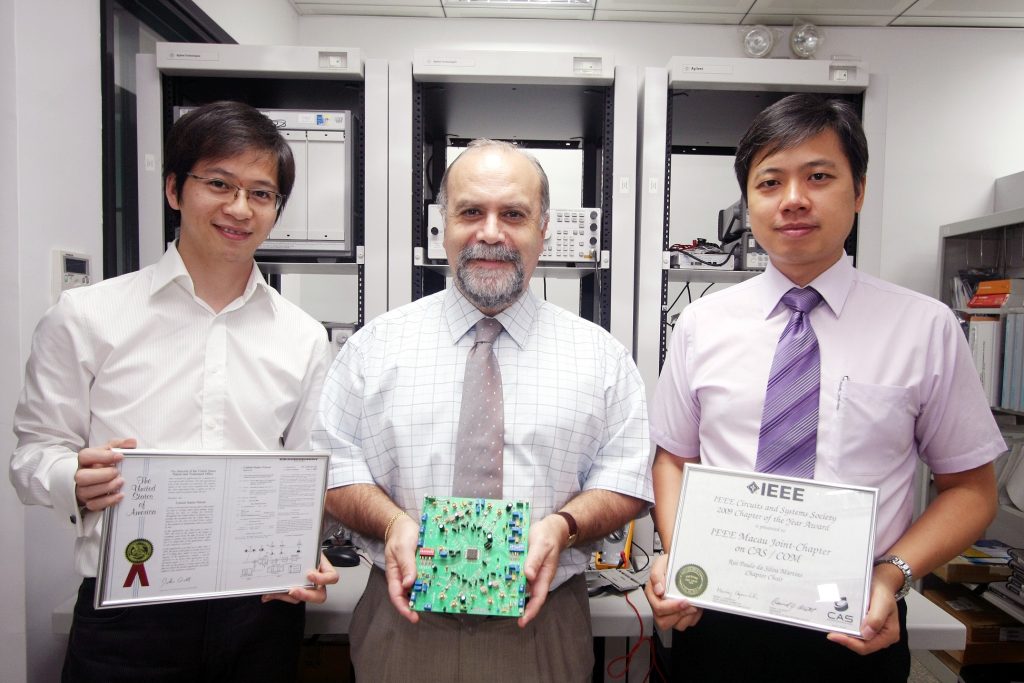
University of Macau is awarded Macao’s first US patent in microelectronics.
While previous teaching at the University had covered the basics of electronics, this field develops too quickly for such a basic education to be globally competitive. Going forward, the University fostered new research programs, and established feedback cycles between research and teaching to ensure students studied state-of-the-art electronics. Master’s students took a mandatory course titled Introduction to Research, which motivated them to undertake their own original research. Students were also given the option to specialise further than had previously been supported.
The University then launched a project entitled UMCHIP – a collaboration with Professor Martins’ alma mater, the Technical University of Lisbon. This new microelectronics project led to the design of the first integrated circuit in Macao. Remarkably, the whole circuit was built without specialised laboratory equipment with a budget of just €4,000.
In addition to developing its research opportunities, the University also launched an outreach program in high schools to attract more students to engineering and technology, which led to a significant increase in enrolment.
This was the start of a positive feedback cycle. In 1994, the University had just two students enrolled in PhD programs. This number grew to 22 in 2002, and by 2013, there were 455 students undertaking PhD projects at the University. This dramatic increase in PhD students lead to over 500 publications per year by 2013, in prestigious journals and conferences around the world. The University began offering scholarships for such students, covering tuition fees and providing a monthly stipend. Now, in 2022, the University has over 1,800 PhD students and will achieve over 3,000 publications and more than 20,000 citations.
This change required the careful cultivation of the best performing students, nurturing their education on the most recent research, and encouraging their initial forays into conducting research of their own. This led to more research and better teaching, which attracted more students who arrived with ever greater ambition.
These changes, as well as quality standards passed by the government, led to Portugal recognising the University of Macau’s engineering degrees in 1997, which fostered further collaboration between Macao and Lisbon.
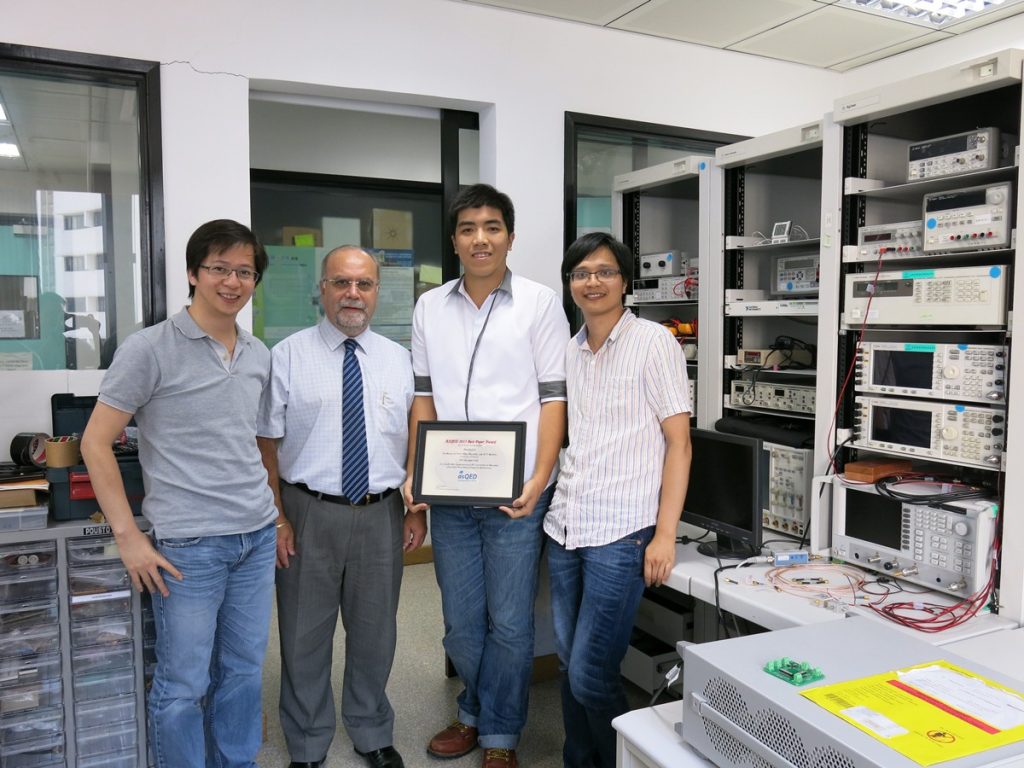
Lei Ka Meng receives Best Paper Award at the Fifth Asia
Symposium on Quality Electronic Design.
Establishing a World-Class Research Group
By 1994, Professor Martins had become the Dean of the Faculty of Science and Technology at the University of Macau. The faculty grew larger and more diverse, as staff were recruited for new positions such as teaching assistants and dedicated lecturers. With a growing staff and a greater focus on quality teaching and research, this new system led to more research, publications, and recognition for the University and its Faculty of Science and Technology.
In 2003, the precursor to the SKL-AMSV Laboratory was officially created by Professor Martins and his former local student Professor Ben U. Initially, the Laboratory was located in a garage on campus, and later moved to two rooms in another University building. In 2005, when the Macao Science and Technology Development Fund was launched, Professor Martins successfully applied for research funding for the new Laboratory, allowing its research achievements to surge.
In 2010, two papers from his research group were selected to be presented at the International Solid-State Circuits Conference (ISSCC) in 2011 – the world’s leading forum for presenting the latest advances in microelectronics research. Soon after, the Ministry of Science and Technology of the People’s Republic of China granted ‘State Key Laboratory’ status to Professor Martins’ lab, and SKL-AMSV was officially established.
In 2014, the Laboratory moved to the University’s new campus in Hengqin, Macao, allowing it to grow further and produce even more world-leading research. Since then, dozens of papers from SKL-AMSV have been selected for presentation at the International Solid-State Circuits Conference (ISSCC). At the 2019 conference, eight papers were selected, and the Laboratory was ranked second in the world for its contributions to microelectronics research, next only to Intel. Recently, the results for the 70th edition of this conference, ISSCC 2023, were revealed and University of Macau (with SKL-AMSV) is the leading institution in the world, with 15 papers or chips accepted!
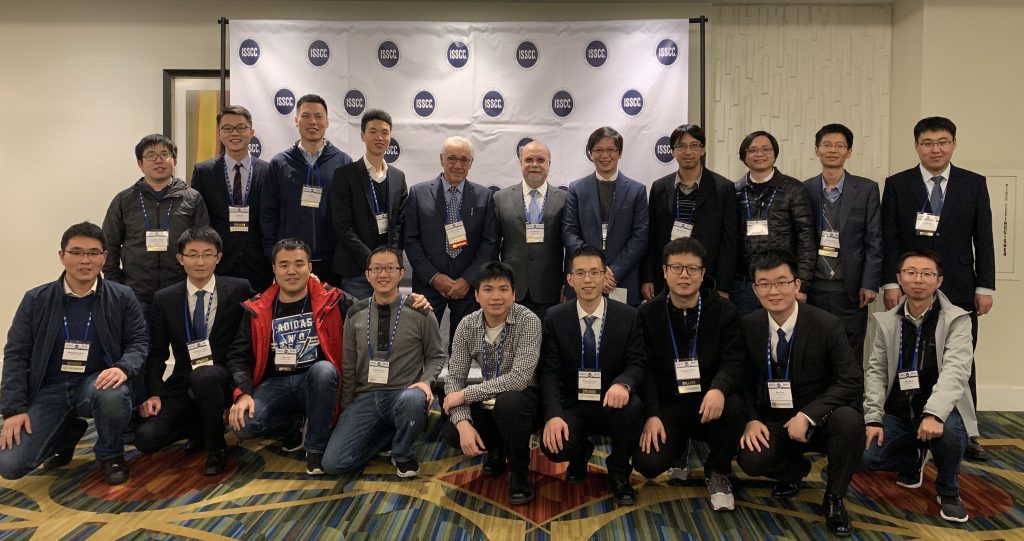
University of Macau team at the ISSCC 2019 in San Francisco.
Interdisciplinary Specialisation
The growing body of published research, including hundreds of research papers, has established SKL-AMSV and the University of Macau as a centre for excellence in electronics research.
The first research projects studied data conversion and signal processing, generating both fresh insights and novel problems for students to pursue. This natural specialisation allowed Professor Martins and his team to find a niche while they grew, without requiring a long-term, strategic agenda. Instead, a ground-up approach granted the researchers with the freedom to make the best use of the limited resources that were available at each stage.
The team began to collaborate across disciplines, leading to the study of a particular specialism within SKL-AMSV known as microfluidics, which was first introduced to the Faculty of Science and Technology by a visiting professor. Specialising in the interdisciplinary field of microfluidics allowed the SKL-AMSV researchers to develop chips that can process DNA samples, towards providing fast disease diagnoses and even measuring the resistance of certain infectious diseases to antibiotics.
Recently, the team’s research has branched out to develop bi-directional transceivers that enable wireless charging – using one phone to charge another without wires. In fact, SKL-AMSV researchers built the world’s first fully integrated wireless charging system, earning researcher Yan Lu the ISSCC 2017 Takuo Sugano Award for Outstanding Far-East Paper.
SKL-AMSV continues to grow and garner international recognition, nurtured by the vision and strategic agency of Professor Rui Martins. The State Key Laboratory is now led by Professor Elvis Mak, a local former PhD student who graduated in 2006 and became Full Professor in 2017. Professor Mak has also served as the Overseas Expert of the Chinese Academy of Sciences (2018), IEEE Fellow (2019), and recently also received the Xplorer Prize from the Tencent Foundation (2022). Under his leadership, SKL-AMSV promises to keep enhancing its approach to teaching, and will continue to produce world-renowned innovations in microelectronics, microfluidics, and beyond.
SHARE
DOWNLOAD E-BOOK
REFERENCE
https://doi.org/10.33548/SCIENTIA854
MEET THE RESEARCHER
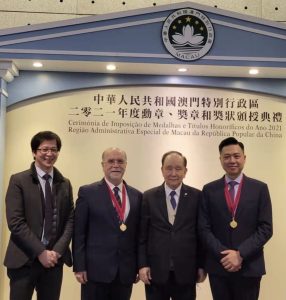
February 2022 – Professors Rui Martins, Ben U and Elvis Mak with Mr Tong Chi Kin (Chairman of Macao Science and Technology Development Fund in 2011).
Rui Martins
State Key Laboratory of Analog and Mixed-Signal VLSI
University of Macau
Macao
China
Professor Rui Martins studied electrical engineering at the Department of Electrical Engineering and Computers within the Instituto Superior Técnico at the University of Lisbon, Portugal. He received his PhD in 1992, and the Habilitation Degree for Full-Professor in Electrical Engineering and Computers in 2001. Professor Martins is the founder of the State Key Laboratory of Analog and Mixed-Signal VLSI (SKL-AMSV) within the Faculty of Science and Technology at the University of Macau. The Laboratory has grown dramatically since it was first established, becoming a world-renowned, state-of-the-art research hub. Professor Martins is a prolific researcher, with over 800 publications that have together received 10,000+ citations. From 1994 to 1997, he was the Dean of the Faculty of Science and Technology, and he has been the University’s Vice-Rector since 1997. Today, Professor Martins continues to guide SKL-AMSV, developing both award-winning microchips, and nurturing remarkable students working on multidisciplinary research projects.
CONTACT
E: rmartins@um.edu.mo
W: https://rto.um.edu.mo/prof-rui-paulo-da-silva-martins/
KEY COLLABORATORS
Instituto Superior Técnico, University of Lisbon, Portugal; University of Pavia, Italy; Hong Kong University of Science and Technology, Hong Kong, China; Tsinghua University, Beijing, China; Fudan University, Shanghai, China; University of Electronic Science and Technology of China, Chengdu, China; Southern University of Science and Technology, Shenzhen, China; University of Malaysia; University College Dublin, Ireland; Interuniversity Microelectronics Centre, Belgium; Harvard University, USA; Stanford University, USA; International Iberian Nanotechnology Laboratory, Portugal; New University of Lisbon, Portugal.
FUNDING
This work was supported by University of Macau and the Macao Science and Technology Development Fund under Grant SKL-AMSV(UM)-2020-2022.

REPUBLISH OUR ARTICLES
We encourage all formats of sharing and republishing of our articles. Whether you want to host on your website, publication or blog, we welcome this. Find out more
Creative Commons Licence (CC BY 4.0)
This work is licensed under a Creative Commons Attribution 4.0 International License. 
What does this mean?
Share: You can copy and redistribute the material in any medium or format
Adapt: You can change, and build upon the material for any purpose, even commercially.
Credit: You must give appropriate credit, provide a link to the license, and indicate if changes were made.
SUBSCRIBE NOW
Follow Us
MORE ARTICLES YOU MAY LIKE
Professor Giorgio Buttazzo | Artificial Intelligence and a Crossroads for Humanity
Where do we stand with artificial intelligence? Might machines take over our jobs? Can machines become conscious? Might we be harmed by robots? What is the future of humanity? Professor Giorgio Buttazzo of Scuola Superiore Sant’Anna is an expert in artificial intelligence and neural networks. In a recent publication, he provides considered insights into some of the most pressing questions surrounding artificial intelligence and humanity.
WVU ADVANCE Center | West Virginia University Team Fosters Group-Level Equity and Inclusivity at Higher Education Institutions
Despite ongoing efforts to broaden participation in the academy, many groups remain underrepresented. More needs to be done to ensure that all faculty and students succeed in institutions of higher education. The WVU ADVANCE Center is an academic hub at West Virginia University, which provides services, events, mentorship opportunities, and other initiatives that promote the sense of belonging that leads to thriving faculty and students.
Professor Martin Trefzer | Bridging Nature and Artificial Intelligence for Smart Electronics Technology
The ever-developing world of artificial intelligence (AI) stands at the tip of a transformative breakthrough. Professor Martin Trefzer from the University of York and Professor Jim Harkin from Ulster University have introduced a revolutionary approach to neural network design. They work on an electronic system based on AI that forms the basis of the cross-disciplinary project called Nervous Systems, which aims to build electronic neuromorphic devices with an artificial intelligence system mirroring the adaptability and responsiveness of biological neural systems.
Dr Jon Tore Lieng | Dynamically Installed Anchors for Floating Offshore Turbines
Effectively harnessing offshore wind presents a valuable opportunity to increase energy supplies. Floating wind turbines present several advantages over traditional fixed turbines in more shallow waters. Dr Jon Tore Lieng from Deep Sea Anchors and colleagues have developed a type of dynamically installed anchor to hold the structures in place while reducing both the costs and complexity associated with installation where cohesive seabed sediments are realised.

